by Winding Pathways | Apr 15, 2021 | (Sub)Urban Homesteading, Energy Efficiency
During recent cold months, we’ve been day-tripping to many museums as we research our articles for the Cedar Rapids GAZETTE.
On an early March morning electric car specialist, William Weiland, at Cedar Rapids McGrath Chevyland showed us how to drive a Bolt, a completely electric car. Soon we sped the 70 miles to Dubuque without burning a drop of gas. After a pleasant and productive visit to the Mississippi River Museum and Aquarium and picnic at Mines of Spain, we drove back to Cedar Rapids and returned the car.
First Experience
It was our first experience driving a totally electric vehicle. We were impressed. As is common with anyone considering going electric, we worried about having enough battery capacity for the 160 miles we drove on a cold, windy day. We didn’t need to worry The Bolt’s “gas gauge” is an easily viewed display of electricity used and remaining and clearly shows how many more miles we could go until the battery was drained. We could have done our Dubuque trip and continued another 50, or so, miles before it needed recharging.
How Does the bolt Compare?
We own and like a Chevy Cruze, which is an efficient and comfortable gasoline engine car. It is approximately the same size as the Bolt, so our drive gave us an opportunity to compare similarities and differences between cars. Here’s what we noted about the Bolt:
- It’s fast and powerful. Step on the acceleration pedal and it smoothly and quickly powers forward. The Bolt is gutsier than our Cruze.
- It’s quiet.
- It’s comfortable. Much more legroom for front-seat occupants than the Cruze, although the back seat has less legroom.
- It’s an engineering marvel. The Bolt goes about 280 miles on a charge and can be recharged in several ways. It lacks nothing in electronic capability. Just about any device can be connected, and the audio was of top quality.
-

-
Two forms of transportation
-
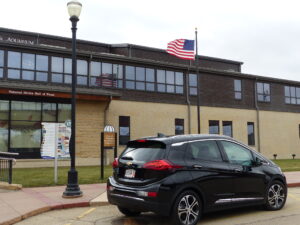
-
Maintenance costs are low on a Bolt.
How Does a Bolt Work?
- It regenerates energy. This took a bit of getting used to. When going down a hill or slowing for a red light or stop sign the Bolt automatically “brakes.” Although it really isn’t braking. Taking a foot off the acceleration pedal causes the car to slow and stop by generating electricity that is later used for forward motion. So, it’s slowing the car without engaging brakes. We found it important to ease our foot pressure off the accelerator pedal to slow down rather than taking the foot off immediately. This avoids being rear-ended by vehicles behind us. After getting the hang of this we really liked the feature. The Bolt has conventional brakes and a brake pedal that can be used. But, because of regenerative braking, the conventional brakes are used much less than on a gas car, so they last longer.
- It’s efficient. We used 50 Kilowatt-hours of electricity from the battery to go 160 miles or just over three miles per KWH. Our electric utility charges us 11 cents a KWH at home, so charging the Bolt would cost about 3.7 cents a mile. Our Cruze gets about 36 miles to the gallon on cold windy days and gas costs about $2.80 a gallon as we write this. That’s about 8 cents a mile or a hair over double the bolt’s fuel cost. Gas prices are rising faster than electricity so the gap will widen.
Maintenance Matters
- Maintenance needs and costs are lower. Electric cars do not need oil changes, since they have no oil. Also, no radiator or need to change coolant. No spark plugs to change. Basically, maintenance involves rotating tires.
-
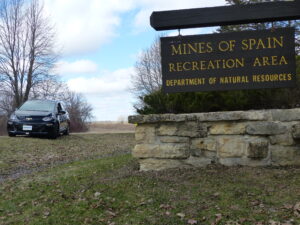
-
The Bolt is quick and agile.
-
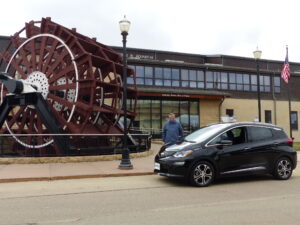
-
A tall person has plenty of legroom in a Bolt.
Overall Impression and Conclusion
Before our test drive, we thought we might buy an electric car in the future. Now we’re certain we will. General Motors will switch to entirely electric vehicles, and many other car companies are also making the transition. It’s transformative. As more electrics hit the road more charging stations will appear and technology will continue to advance. We are entering an electric future that will be cleaner and quieter than our petroleum present.
* Winding Pathways was not paid to review the Chevy Bolt. Ours is an independent review.
* For another independent review see www.caranddriver.com/chevrolet/bolt-ev.
by Winding Pathways | Apr 1, 2021 | (Sub)Urban Homesteading, Garden/Yard, Garden/Yard, Nature
Winter Wanderers
We’ve been having more adventures with possums. Marion spotted a new visitor to the bird feeder one late February afternoon.
It was a smallish opossum. We called him “Pogo” after one of our favorite cartoon characters but didn’t realize we’d be playing tag with him (or her) for the next few weeks.
Pogo’s Feet
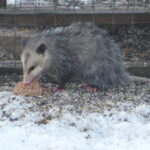
Possums’ feet help it hold food and climb.
Many people dislike possums and think they’re ugly and dumb. We like ‘em. They’re fascinating and love to eat ticks, including those that spread Lyme Disease. We find their paws especially interesting. Take a look at Pogo’s feet in the photos. They’re like strong-clawed hands that let him climb.
We spotted Pogo a few evenings later sniffing around our composter. He ambled off and scooted under a brush pile, where we assume he lived. That’s a fine place for an opossum to live so we left a scoop of dog food nearby for a late-night snack.
The next night Rich went out after dark to check the chickens in the barn. He turned on the light and there, staring at him from inside, was Pogo. Now, we like possums but not when they’re in the barn near the chickens.
Quite Comfortable

After eating an egg, Pogo took a nap.
I wondered, how in the world did he get in? We searched high and low for holes in the building big enough for a smallish opossum to squeeze through. There weren’t any, so we assumed he probably scooted in the open door during the day unseen. Rich ushered him out.
We didn’t see Pogo after that for a few days until Rich went out to gather eggs. There was Pogo napping in a nest! Our possum never seemed aggressive. He didn’t growl, snarl, or attempt to bite the shovel Rich used to scoot him out the door. He just opened his toothy mouth, stared at Rich as if to say, “What’s the problem?” and ambled to the brush pile. Again, we looked for possible openings and didn’t find any.
Quite at Home
No sign of Pogo for two more days. Then it was coop spring cleaning time. The chicken’s waterer was perched on two cinder blocks. Rich removed the waterer and went to pick up a cinder block when he saw a nose pointing out. There sat Pogo, curled up snugly inside one of the block’s cavities.

Opossum curled up in cinder block nest.
Again, all he did was stare and open his mouth as Rich explained that he was welcome to live under the brush pile but not in the barn.
We think we have the mystery solved. Pogo didn’t come into the barn after dark. He walked right through the chicken’s pop hole door when it was open during the day and made a home in the cinder block. It’s a great possum spot. He slept on soft wood chips and had plenty of fresh water and chicken feed nearby. Pogo probably snacked on an egg or two but never attempted to catch or kill a chicken.
We still want him to live in the brush pile but not in the barn. So, we now carefully monitor every nook and cranny in the barn before we lock the door at night. We haven’t seen Pogo in the coop lately and hope he’s relocated permanently to the brush pile.
by Winding Pathways | Mar 18, 2021 | (Sub)Urban Homesteading, Birds, Garden/Yard, Nature, Trees/Shrubs
March is a pivot month. It’s neither winter nor spring. Often called “mud season”, March is maple syruping time, but it’s also birdhouse building month at Winding Pathways.
As humans in northern climates wade through mud and long for spring, millions of birds far to the south are planning their long migration north. A few hardy waterfowl arrive as soon as the ice melts from lakes and ponds, but most birds appear, as if by magic, in April and May. We make sure our birdhouses are up before they arrive.

Looking out at the world.
House Wrens, Eastern Phoebes, American Robins, House Sparrows, and House Finches all nest on or near homes, barns, and garages. Although few people enjoy seeing messy House Sparrow nests tucked into nooks and crannies, most love hosting the native species as they raise the new generation outside the window.
Make Birdhouses
March is the best month to make birdhouses and restore older ones somewhat worse for the wear. Most are easy to build using simple carpentry tools. Better yet, birds aren’t fussy. Although the size of the house and the diameter of the entrance hole is important, the residents don’t care if the maker is an excellent carpenter or a novice. So, if the joints don’t fit perfectly it won’t bother birds!
Helping children make birdhouses is a fun project that involves them in nature as they learn safe tool use and basic construction techniques.
We scrounge a nearby pallet pile for free wood. Often the discarded pallets are made from boards the right width for our houses. Relatively inexpensive pine, spruce, or fir work for people who prefer to buy wood.
-
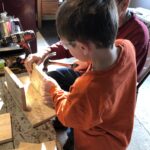
-
Working with children to make a birdhouse is rewarding.
-

-
Children learn wood types, stages of building and how tools work.
-
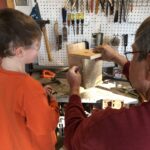
-
The birdhouse is nearly complete.
Great Resources to Guide Your Work
The best information source for virtually anything about wild birds is the Cornell University Laboratory of Ornithology. Their website gives great information on many aspects of birds, including what species likely live in an area. The site is complex but fascinating. A second website, also by the Lab, is more specific to birdhouses and nesting. The Laboratory of Ornithology site helps anyone predict what birds might migrate to their yard and when they’ll arrive. It also includes plans on how to build birdhouses. There’s even a video showing construction tips.
There’s more to birdhouses than just making one. They must be erected in the right place and height above the ground. The Lab’s website provides the right information. And, here are two tips from Winding Pathways.
Tips from Winding Pathways
- Many birdhouse plans to use nails as a hinge so the house can be opened for cleaning. We buy and use small hinges, hooks, and eyes to make opening the box to clean it easier.
- It’s tempting to attach a birdhouse to a tree using a nail or screw. That may work but eventually, the birdhouse falls off. But, the metal remains embedded in the tree. This creates danger as the tree grows around the metal, hiding it. Hitting a nail with a chainsaw is downright scary and dangerous. Also, driving a nail into a live tree can introduce diseases that could kill it. We use wire or rope to attach our birdhouses to live trees and use screws to attach birdhouses to nonliving posts and poles. One of our wren houses is suspended from a hook screwed into our porch ceiling.
Building birdhouses and enjoying a wren couple raises a brood is a fun family activity that we never tire of.
by Winding Pathways | Mar 11, 2021 | (Sub)Urban Homesteading, Birds, Pests
Millions of people love their cats. Some 36% of households keep an average of two cats. They are the second most popular companion animal in the United States, lagging only behind dogs.

Cats decimate bird populations.
Some cats cause problems, especially when owners allow them to free-range the neighborhood. According to the American Bird Conservancy, they kill 2.4 billion birds a year and may be a significant cause of the decline of many species.
Catios to the rescue!
A growing number of cat lovers, many who also enjoy bird watching, recognize the problem and are increasingly adding a catio to their home. Wonder what it is???? It’s simply an enclosure that allows the family cats to enjoy fresh air, sunshine, and a bit of adventure without allowing them complete access to the neighborhood.
Many catios are enclosed patios, which spawned the name, that let cats play outdoors while their owners enjoy lounging or socializing nearby. They are relaxing places for both species. Other catios are small and positioned outside windows. Catios can be either purchased or homemade and often an existing patio can be modified into one.
Safety First!
Although cats love roaming the neighborhood, it is not a safe place. They pick up ticks and transfer them to humans, suffer accidents, are killed by cars as they cross streets, and are taken by predators.
A catio is a good solution to several problems. It allows cats to enjoy the outdoors safe from cars and predators in a place where they can’t kill birds. And, the owners always know where their cat is.
Harmony
An array of catio photos is visible on Catio Spaces. Many other websites feature them. Catios are a great way for cat lovers to show care of wildlife species, keep their cats safe, and live in peace with human neighbors who are frustrated when they spot a feline stalking birds under their feeder.
by Winding Pathways | Mar 4, 2021 | Garden/Yard, Mammals
Bright sun and warm breezes broke Iowa’s February subzero weather. Being outside unencumbered by thick gloves, boots, and coats felt great, and we even enjoyed a cup of coffee sitting outside on the sunny side of our home. We weren’t alone. A glance at the bird feeder one late afternoon revealed a friend we hadn’t seen in months. An opossum was enjoying a meal of seeds while basking in the relative warmth. We suspect the animal had spent frigid days and nights dormant under a brush pile.
Many people don’t like possums but we do. They’re fascinating – and helpful! The Iowa DNR lists these little-known facts about Iowa’s only marsupial, an animal that cares for its young in a pouch similar to the Australian kangaroo.
-
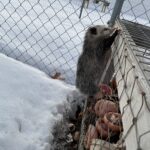
-
This young possum climbs up the compost bin to scavenge food.
-
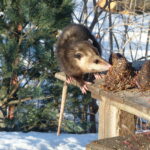
-
In broad daylight this possum feasted on a block of seeds.
-
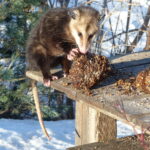
-
Possums have agile hands.
Fun Facts About Opossums
- Possums are virtually immune to rabies.
- A copperhead or rattlesnake might bite a possum and be surprised. These ancient animals are immune to their poison and will likely gobble up the hapless snake for lunch. Not so much in Iowa. Poisonous snakes are rare here and only found in a few areas.
- No other native mammal has as many teeth. Opossums have 50. When approached they’ll often open their mouth and show them off. They also might hiss, but our possums didn’t make any threatening moves.
- Possums play possum. It discourages some predators but doesn’t work with cars. Many are killed as they crossroads. Do avoid hitting them.
- Possums have hind feet that look a bit like a human hand. Their tracks in the snow are distinctive.
- Female opossums have 13 teats. Twelve are in a circle in her pouch with one in the center.
- Babies are tiny. The size of a dime. After birth, they finish developing in mom’s pouch. When they are older, they’ll often ride on her back.
- Some sources say opossums reduce tick numbers. They often groom themselves and consider any tick they find a tasty snack.
We enjoy seeing our opossum friends. On cold nights we sometimes put a little cat or dog food out for them. Life’s not easy for these animals with naked tails and thin fur, so we try to help them.
by Winding Pathways | Feb 25, 2021 | (Sub)Urban Homesteading, Garden/Yard, Garden/Yard, Nature
November 5, 2020, was a perfect day for burning our prairie. We’d enjoyed several days of dry weather, and had our fire permit. We just needed a bit of breeze.
On that gorgeous day we burned the labyrinth, the backyard prairie, and our savanna…….and then we struck a match into our newest prairie. With the help of Linn County Roads and Air Pollution Departments, Pheasants Forever, the Monarch Research Project, UNI, and Sustainable Landscape Solutions we had prepared the soil and killed the weeds last May. Then we broadcast a native seed mix containing 82 species.
Prairie’s slow to start. We didn’t expect much this first year and ended up with lots of crabgrass. It grew to about 8” and dried out nicely. A slow fire removed most of it, allowing sunshine to warm prairie plants beneath. We expect a resurgence of delightful plants next spring and summer.
-

-
We burned the new prairie to encourage the native plants.
-

-
Several organizations and businesses are collaborating to create and manage the prairie.

















